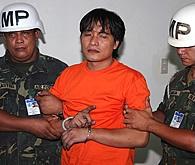|
|
|
Ahmad Santos, captured in October 2005. |
The US Treasury Department has added the Philippines-based Rajah Solaiman Movement and its leader to the list of Specially Designated Global Terrorists. The Rajah Solaiman Movement has close links to Abu Sayyaf and Jemaah Islamiyah, and has been behind multiple attacks in the Philippines.
The Rajah Solaiman Movement has “received training, funds, and operational assistance from ASG [Abu Sayyaf] and Jemaah Islamiyah [JI],” the Treasury press release stated. “RSM, in return, has provided field operatives and a pool of potential recruits to the ASG and JI, enabling them to expand their reach into the urban areas of the Philippines.”
The terror group began receiving funds from “private Saudi sources that channeled funds through charitable NGOs in the Philippines” starting in 2004. “Between 2002 and late 2005, Saudi financiers and at least one Saudi-based Filipino financier also contributed funds to RSM for its training camps and planned terror operations.”
Background on the Rajah Solaiman Movement
The Rajah Solaiman Movement was founded by Ahmad Santos, a Christian convert to Islam. The movement seeks to establish an Islamic state in the Philippines.
While its strength is estimated at approximately 30 members, the Rajah Solaiman Movement is of special interest to Manila because it consists of Catholic converts to Salafism. These recruits are better able to penetrate and infiltrate non-Muslim regions of the Philippines, including Luzon, without giving away a southern accent or ethnic appearance.
The group extends the capabilities of Abu Sayyaf for large-scale terror operations outside and beyond Jolo, Sulu and Mindanao islands. Together with Abu Sayyaf, the Rajah Solaiman Movement was responsible for the Super Ferry 14 attack in 2004 that killed 116 people. The ferry bombing was the world’s worst maritime terror attack in recent years. The two terror groups also cooperated with the simultaneous Valentine’s Day bombing attacks in February 2005 that resulted in 16 people killed.
“RSM members were involved in several plots to bomb high-profile targets, as well, including Manila public utilities, tourist areas, and the U.S. Embassy in Manila,” the US Treasury reported.
Ahmad Santos, Feliciano de los Reyes, and several other high-profile leaders in the Rajah Solaiman Movement have been captured over the past several years.
Nick Grace contributed to this report.








